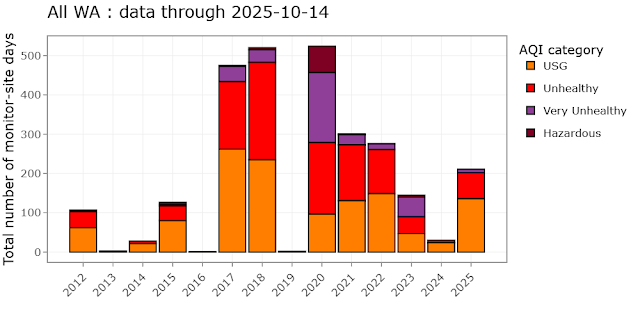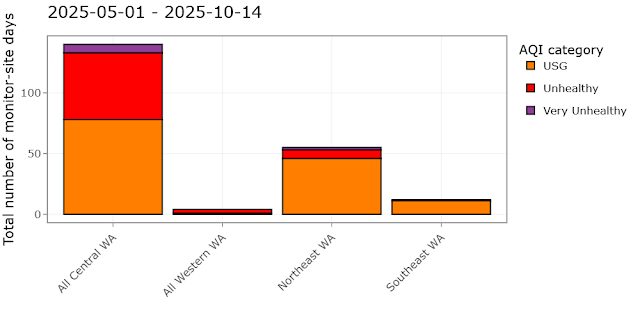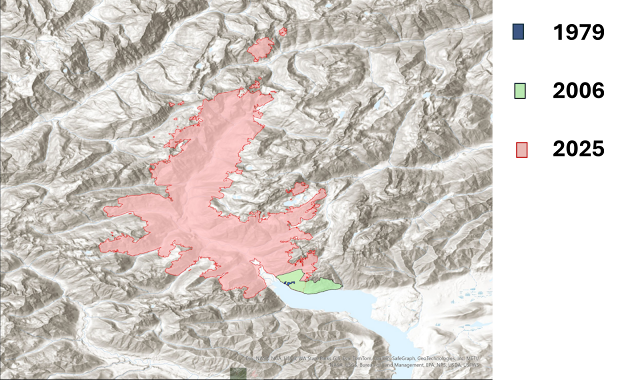
Smoke from the Bear Gulch Fire, the largest wildfire in Olympic National Park history
The Wenatchee area continues to see some smoke impacts from the Labor Mountain Fire, but recent rain and cooler weather mean wildfire season is winding down. It's a good time to look back at this year's wildfire season from an air quality perspective.
Statewide overview
This year, the smoke season began quietly. Up until mid‑August, there were very few days with high levels of PM2.5 (fine particles, the main pollutant in wildfire smoke) based on data from 133 air quality monitors tracking PM2.5 across the state. (Air monitoring sites do not cover every location in the state. Some areas saw worse smoke than the statewide network reported.) Early season smoke impacts were localized, mostly around the Bear Gulch Fire near Lake Cushman and the Pomas Fire northwest of Entiat.
Conditions changed quickly at the end of August. A combination of lightning-sparked wildfires, hot and dry weather, and light winds caused unhealthy air quality days across Central and Eastern Washington. Overall, the 2025 season ended up resembling 2021 and 2022 more than the relatively smoke-free 2024. Days with air quality in the categories of unhealthy for sensitive groups (USG) or worse, as reported by air quality monitors
While no region was entirely free from smoke, Central Washington was hit the hardest. The Wildcat, Lower Sugarloaf, and Labor Mountain fires were the biggest fires in this area. Although the Pomas Fire started early in the season, it affected air quality less than the larger, more smoke-producing fires. Northeast Washington also saw lasting smoke impacts from several fires in September. Southeast Washington dodged most of the heaviest smoke, but still experienced some smoke that drifted into the region. Western Washington experienced occasional periods of smoke from regional fires when shifting winds carried smoke toward the Puget Sound and Northwest Washington. Days with air quality in the categories of unhealthy for sensitive groups (USG) or worse, as reported by air quality monitors, sorted by region
To better show the timing of smoke impacts this summer, the plot below shows daily air quality levels for each county with an air quality monitor. Each row represents the daily average from the most impacted monitor in that county, with counties organized by geographic region. Aside from localized impacts at Lake Cushman, most of the state experienced good and moderate air quality for most of the summer. Fire activity ramped up significantly at the end of August and into September. Daily AQI for each county (including temporary air monitoring at Lake Cushman) this summer
The Bear Gulch Fire
The 2025 perimeter of the Bear Gulch Fire (big pink area, center) compared to previous fires in 2006 (small green area, lower right of pink area) and 1979 (tiny dark blue dots in the green area, lower right of pink area). The light blue area (lower left) is Lake Cushman.
The Bear Gulch Fire near Lake Cushman created an unusual smoke season for Western Washington. The fire, started by human activity on July 6, often caused poor air quality in communities along Hood Canal and in Mason County throughout July, August, and September. Between September 14 and September 20, the fire nearly doubled in size, growing from 10,851 acres to 19,092 acres. This rapid growth caused several hours of unhealthy air in Port Angeles on September 16-17, and in Mason and Thurston Counties on September 19-20.
At just over 20,000 acres, the Bear Gulch Fire holds the record as the largest wildfire in the Olympic National Park since it was established in 1938, breaking the previous record of 1,175 acres. Between 1985 and 2024, roughly 900 recorded wildfires burned a total of 4,300 acres in the Olympic National Park. Major fires in the Olympics typically burn between 10 and 500 acres. While they often smolder for several weeks, the smoke doesn't usually travel very far. The Bear Gulch Fire produced multiple pyrocumulus clouds, hazy skies, and even a visible smoke plume that stretched across the state on August 13.
The first wetting rains fell over Bear Gulch in early October. Continuing showers have dramatically slowed fire growth and smoke production. All evacuation orders have been lifted and the U.S. Forest Service has moved fire management to local units.
Bear Gulch burn scar from satellite imagery on October 13, 2025






